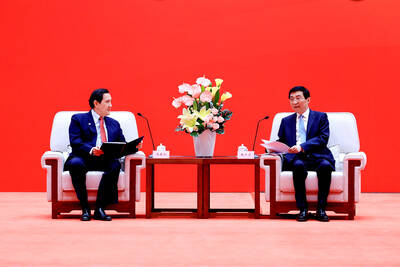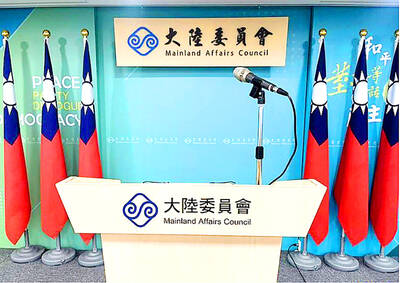The military is evaluating two US-made long-range early warning radar systems to be used in the construction of a defense shield against Chinese ballistic missiles, according to a report in Jane's Defense Weekly.
One of the systems is a modified version of Raytheon's AN/FPS-115 phased-array radar PAVE PAWS system, while the other is Lockheed Martin's AN/SPY-1D(V) system, the magazine's latest issue says.
Quoting an anonymous US government source, the report said that the two systems provide "an autonomous means for early warning for ballistic missile launches, which would give Taiwan time to initiate civil defense measures and activate Taiwan's Patriot PAC-II Plus [air defense] system."
The PAVE PAWS was initially considered to be the only choice for Taiwan when the US government announced last year its agreement to sell a long-range early warning radar system to Taiwan. The system was favored partly because of its 5,600km range, which would enable Taiwan to monitor almost all of China's territory.
But now the matter has taken on a new twist because of a rumored US government plan to provide Taiwan with a shorter-range radar system, instead of the 5,600km package. Lockheed Martin has thus emerged as a competitor to Raytheon in the deal, offering an option that is more likely to be accepted by the US.
Representatives from both arms manufacturers have visited Taiwan in the past few months to lobby for the lucrative deal. The military is now trying to determine which of the two systems would best serve Taiwan's needs for the construction of a defense shield against a Chinese ballistic missile threat.
Taiwan currently has no early warning system against ballistic missiles and only has limited interception capability against ballistic missiles, namely its Patriot PAC-II Plus system.
Chang Li-teh (
"The PAVE PAWS, to be housed in a 10-story building, would likely become an easy target for China's anti-radiation or ballistic missiles because of its huge size. It would likely be destroyed by Chinese missiles right after it detects a first wave of ballistic missiles fired from China," Chang said.
"The system was initially designed ... as a defense against the Soviet Union's intercontinental ballistic missiles armed with nuclear warheads. It may not suit our current defense needs," he said.
But Chang did say that he has consulted with Raytheon staff who told him the PAVE PAWS cannot be easily destroyed.
"The Raytheon staff said China would need to fire at least 100 ballistic missiles to destroy a PAVE PAWS station. These missiles have to have a CEP [circular error probability] of 100m," Chang said.
"Another good thing about the PAVE PAWS is that it ... has a range of 5,600km. But the US government will likely sell us a shorter-range package."
As for Lockheed Martin's AN/SPY-1D(V) system, Chang said it is much smaller than the PAVE PAWS and thus less likely to become a target for Chinese missiles.

BUILDUP: US General Dan Caine said Chinese military maneuvers are not routine exercises, but instead are ‘rehearsals for a forced unification’ with Taiwan China poses an increasingly aggressive threat to the US and deterring Beijing is the Pentagon’s top regional priority amid its rapid military buildup and invasion drills near Taiwan, US Secretary of Defense Pete Hegseth said on Tuesday. “Our pacing threat is communist China,” Hegseth told the US House of Representatives Appropriations Subcommittee on Defense during an oversight hearing with US General Dan Caine, chairman of the Joint Chiefs of Staff. “Beijing is preparing for war in the Indo-Pacific as part of its broader strategy to dominate that region and then the world,” Hegseth said, adding that if it succeeds, it could derail

CHIP WAR: The new restrictions are expected to cut off China’s access to Taiwan’s technologies, materials and equipment essential to building AI semiconductors Taiwan has blacklisted Huawei Technologies Co (華為) and Semiconductor Manufacturing International Corp (SMIC, 中芯), dealing another major blow to the two companies spearheading China’s efforts to develop cutting-edge artificial intelligence (AI) chip technologies. The Ministry of Economic Affairs’ International Trade Administration has included Huawei, SMIC and several of their subsidiaries in an update of its so-called strategic high-tech commodities entity list, the latest version on its Web site showed on Saturday. It did not publicly announce the change. Other entities on the list include organizations such as the Taliban and al-Qaeda, as well as companies in China, Iran and elsewhere. Local companies need

CRITICISM: It is generally accepted that the Straits Forum is a CCP ‘united front’ platform, and anyone attending should maintain Taiwan’s dignity, the council said The Mainland Affairs Council (MAC) yesterday said it deeply regrets that former president Ma Ying-jeou (馬英九) echoed the Chinese Communist Party’s (CCP) “one China” principle and “united front” tactics by telling the Straits Forum that Taiwanese yearn for both sides of the Taiwan Strait to move toward “peace” and “integration.” The 17th annual Straits Forum yesterday opened in Xiamen, China, and while the Chinese Nationalist Party’s (KMT) local government heads were absent for the first time in 17 years, Ma attended the forum as “former KMT chairperson” and met with Chinese People’s Political Consultative Conference Chairman Wang Huning (王滬寧). Wang

CROSS-STRAIT: The MAC said it barred the Chinese officials from attending an event, because they failed to provide guarantees that Taiwan would be treated with respect The Mainland Affairs Council (MAC) on Friday night defended its decision to bar Chinese officials and tourism representatives from attending a tourism event in Taipei next month, citing the unsafe conditions for Taiwanese in China. The Taipei International Summer Travel Expo, organized by the Taiwan Tourism Exchange Association, is to run from July 18 to 21. China’s Taiwan Affairs Office spokeswoman Zhu Fenglian (朱鳳蓮) on Friday said that representatives from China’s travel industry were excluded from the expo. The Democratic Progressive Party government is obstructing cross-strait tourism exchange in a vain attempt to ignore the mainstream support for peaceful development